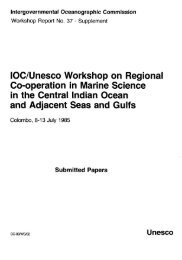ΣΑ =<strong>The</strong> <strong>International</strong><strong>The</strong>rmodynamicEquation <strong>of</strong> Seawater– 2010ΣASummary for Policy MakersWorking Group 127<strong>The</strong> people behind the <strong>equation</strong>“An <strong>equation</strong> giving internal energy in terms <strong>of</strong> entropy and specific volume,or more generally any finite <strong>equation</strong> between internal naenergy, entropy andspecific volume, for a definite quantity <strong>of</strong> any fluid, may be considered asthe fundamental <strong>thermodynamic</strong> <strong>equation</strong> <strong>of</strong> thatfluid, as fromit… maybederived all the <strong>thermodynamic</strong> properties <strong>of</strong> the fluid (so far as reversibleprocesses are concerned).”~ J. W. Gibbs, 1873<strong>The</strong> group tasked with developing the new set <strong>of</strong> highly accurate and comprehensiveformulas used in TEOS-10, the SCOR/IAPSO Working Group 127, began work in 2005and included:Trevor J. McDougall, (chair), CSIRO, Hobart, AustraliaRainer Feistel, Leibniz Institut fuer Ostseeforschung, Warnemuende, GermanyDaniel G. Wright, Bedford Institute <strong>of</strong> Oceanography, Dartmouth, CanadaRich Pawlowicz, University <strong>of</strong> British Columbia, Vancouver, CanadaFrank J. Millero, RSMAS, Florida, USA*David R. Jackett, CSIRO, Hobart, AustraliaBrian A. King, National Oceanography Centre, Southampton, UKGiles M. Marion, Desert Research Institute, Reno, USASteffen Seitz, Physikalisch-Technische Bundesanstalt (PTB), Braunschweig, GermanyPetra Spitzer, Physikalisch-Technische Bundesanstalt (PTB), Braunschweig, GermanyChen-Tung Arthur Chen, National Sun Yat-Sen University, Taiwan, R.O.C.* Member <strong>of</strong> the original committee on EOS-80Josiah Willard GibbsAs previous studies have noted, the EOS-80 <strong>equation</strong> was missing a mathematicalcomponent -- a Gibbs function which physicists had determined for a variety <strong>of</strong> fluids,except seawater. Named after American theoretical physicist, chemist, and mathematicianJosiah Willard Gibbs (1839-1903), a Gibbs function defines a fluid in terms<strong>of</strong> its energy and heat transfer, or <strong>thermodynamic</strong>s. One <strong>of</strong> the first requirements theworking group had to address was incorporating a Gibbs function into the new <strong>equation</strong>for seawater. <strong>The</strong> fundamental work <strong>of</strong> Rainer Feistel at Leibniz Institute for BalticSea Research led to the development <strong>of</strong> a Gibbs free energy function that is the backbone<strong>of</strong> the new <strong>thermodynamic</strong> <strong>equation</strong> <strong>of</strong> state (TEOS-10). Because the composition<strong>of</strong> seawater is different in different locations around the world, another aspect <strong>of</strong>the new <strong>equation</strong> is the provision <strong>of</strong> a practical way to account for these spatial variations.Merging the different seawater properties into one <strong>equation</strong>, the working grouphas mixed 19 th -century theory with 21 st -century computer algorithms.2
75179 γPractical vs. Absolute SalinityA fundamentally different approach todetermining what’s in seawaterIn 1978, oceanographers agreed to use conduc-tivity as the universal method for estimating thesalinity <strong>of</strong> seawater. UNESCO endorsed thismethod, and incorporated the 1978 Practical Sa-linity Scale into its 1980 <strong>equation</strong>s for calculatingthe density <strong>of</strong> seawater (EOS-80).Prior to the Practical Salinity Scale, oceanogra-phers had primarily calculated salinity using titrationmethods that measured the most commonsalt ion: chlorine (see box on page 7: <strong>The</strong> searchfor salinity). <strong>The</strong> conductivity method improvedaccuracy, as it tracked all the ions in the sea andnot just chloride. But calculating salinity fromconductivity, as opposed to traditional chemicalanalysis, required sacrificing the definition <strong>of</strong>salinity. This is because conductivity measuresonly free-floating ions or electrolytes, the samedissolved salts that are found in sports drinks,for example. In fact, any non-conductive material,such as dissolved silicon dioxide, is simplyignored when it comes to practical salinity.Since seawater conductivity can only be preciselyrelated to salinity for a particular chemicalcomposition, applying the 1978 Practical SalinityScale to seawater <strong>of</strong> different compositions canlead to errors. <strong>The</strong>se errors are small in the openocean, but are much larger than the typical precision<strong>of</strong> modern measurements.Water from the North Atlantic with a salinity <strong>of</strong>about 35 parts <strong>of</strong> salt per thousand parts waterhas traditionally been used as a control for comparingother water samples. But as the waterfrom the Atlantic ocean travels around the world,the composition <strong>of</strong> the seawater changes as aconsequence <strong>of</strong> the biogeochemical differencesin the environment. Sinking particles remineralize,adding calcium, carbon and nutrients like silicicacid and nitrate. Once seawater comes intocoastal areas, its composition will also changeas it mixes with river waters, which have dissolvedions in very different combinations fromA Taste for Salt‘In chemistry, any positive and negative ionbound together is called a salt,’ explainsmolecular geneticist and chemosensation(taste and smell) expert Hiroaki Matsunami <strong>of</strong>Duke University in the USA. In the ocean, saltsdissolve into free-floating negative and positiveions, also known as electrolytes. <strong>The</strong>secharged particles are what make it possiblefor electricity to flow through water. <strong>The</strong> sameions that make up the salt used in foods —sodium (Na + ) and chloride (Cl - ) — accountfor more than 86% by weight <strong>of</strong> the 11 majorions in the sea and are what gives the oceanits salty taste. Dried, these ions form table saltand get sprinkled over food.After chloride and sodium, the ocean’s nextmost common ions are sulfate (SO 42-) andmagnesium (Mg 2+ ). How would the oceantaste if these ions were more common? ‘Itasted magnesium sulfate and it tasted reallybad but I wouldn’t call it bitter,’ Matsunamisays <strong>of</strong> the ingredient used in bath salts.seawater. Some <strong>of</strong> these added molecules addto the conductivity, but not in the same way asthe original set <strong>of</strong> ions.Unlike the Practical Salinity Scale, which accountsonly for ions, the new Absolute Salinityincorporates non-electrolytes using tables thataccount for how these additional substancesvary region by region. Once again, the latitudeand longitude at which seawater samples aretaken will play an important role in calculatingsalinity. Unlike the Practical Salinity Scale-- which, as a reference scale, has no unit <strong>of</strong>measure -- Absolute Salinity is a new variablewithin the <strong>thermodynamic</strong> description and ispart <strong>of</strong> the <strong>International</strong> System <strong>of</strong> Units.3
















